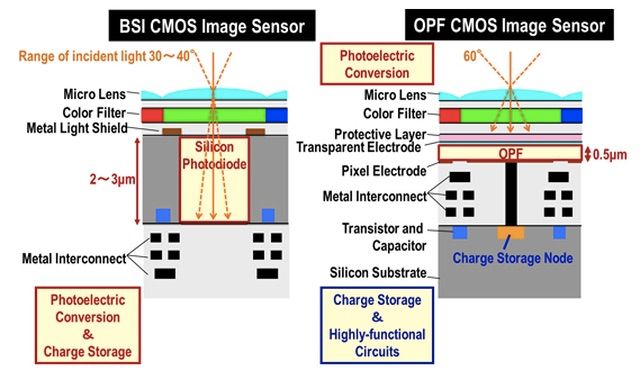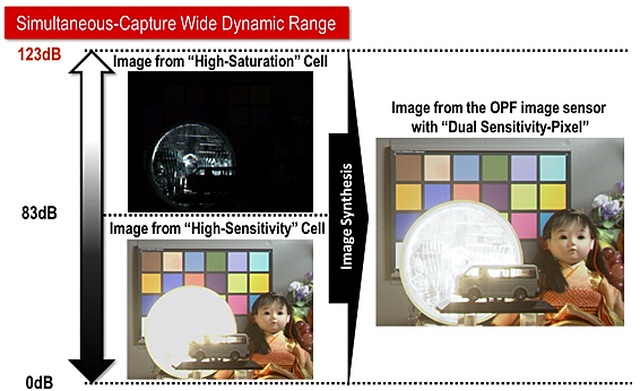Panasonic Develops Organic Sensor with Global Shutter :: Impressive 123dB (!!!) dynamic range :: Made with Fujifilm :)


You might remember how back in November we shared the news that Panasonic will talk about an Ultra Low Noise 120dB+ (!!) Dynamic Range organic sensor on February 1st.
Well, we now have more details about it. Panasonic and Fujifilm are developing a 123dB dynamic range organic sensor (press release here) with global shutter (press release here).
Dicahub speculates that this might be the reason why Fujfilm is building a new plant for advanced semiconductor materials in Taiwan (press release here)
From the Organic Sensor press text:
Panasonic Corporation today announced that it has developed a new wide-dynamic-range[1] technology which can improve simultaneous-capture wide dynamic range[2] 100 times wider than the conventional results, using a CMOS image sensor with an organic photoconductive film (OPF)*2 [we are using an organic photoconductive film (OPF) that FUJIFILM Corporation has developed.] .
1. Wide incident angle (60 degrees), high sensitivity, high saturation and highly-functional circuits due to a unique feature of OPF, in which an OPF for photoelectric-conversion and a readout circuits are independent.
2. 123dB simultaneous-capture wide dynamic range (that is 100x wider than that of common silicon image sensors*3), while maintaining the conventional chip size, due to our original ” simultaneous-capture structure “.
From the Global Shutter press text:
Panasonic Corporation today announced that it has developed a new highly functional global shutter[1]technology for CMOS image sensor using organic photoconductive film (OPF)*1 [we are using an organic photoconductive film (OPF) that FUJIFILM Corporation has developed.] . This technology enables to capture high speed moving object up to 10 times brighter*2 scene in global shutter mode. In OPF CMOS image sensor, charge-storage function and photoelectric-conversion function can be set independently. By utilizing the unique feature of OPF CMOS image sensor, this technology solves the degradation of saturation signal[2] in conventional image sensor with global shutter function. Motion direction can be detected from acquired object’s signal level in one picture by fine control of shutter sensitivity by changing applied voltage to OPF which is hardly realized by conventional CMOS image sensors.
The newly developed highly functional global shutter technology contributes to high speed image sensing of moving objects without image distortion which appears in conventional shutter operation under very bright scene. We expect this technology to be used widely in motion capture applications and also extend to other applications that have been thought to be difficult to realize unless high saturation global shutter or variable sensitivity multiple exposure.
The new technology has the following advantages.
1. Wide incident angle (60 degrees), high sensitivity, high saturation and highly-functional circuits due to a unique feature of OPF, in which an OPF for photoelectric-conversion and a readout circuits are independent.
2. High saturation signal up to 10 times larger*3 than conventional image sensors with global shutter function due to Photoelectric Conversion Controlled Global Shutter Technology.
This development is based on the following new technologies.
1. CMOS Image Sensor Design Technology, in that, an OPF photoelectric-conversion part and a circuit part can be designed independently.
2. Photoelectric Conversion Controlled Global Shutter Technology that is realized by controlling of organic photoconductive film sensitivity.
3. Variable Sensitivity Multiple Exposure Technology which can detect the motion and its direction by changing image capturing sensitivity in each frame.
Panasonic holds 60 Japanese patents and 41 overseas patents (including pending) related to this technology.
Panasonic will present part of the research at the international conference ISSCC (International Solid-State Circuit Conference) 2016 which is to be held in San Francisco, USA on January 31 to February 4.
Notes:
*1: We are using an organic photoconductive film (OPF) that FUJIFILM Corporation has developed.
*2: Saturation signal per pixel area, compared with conventional silicon based CMOS image sensor with global shutter function.

